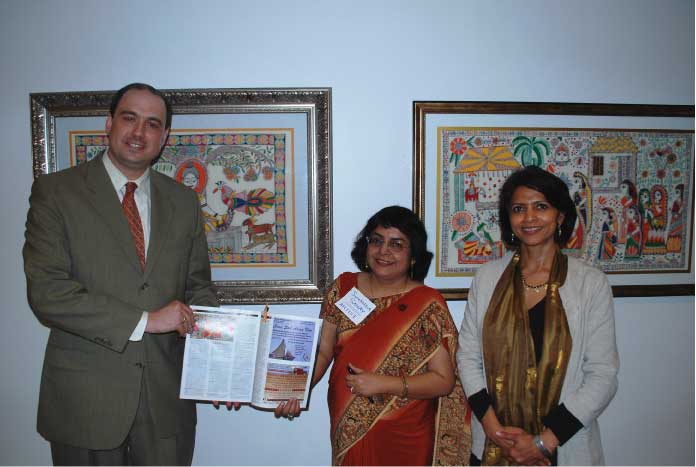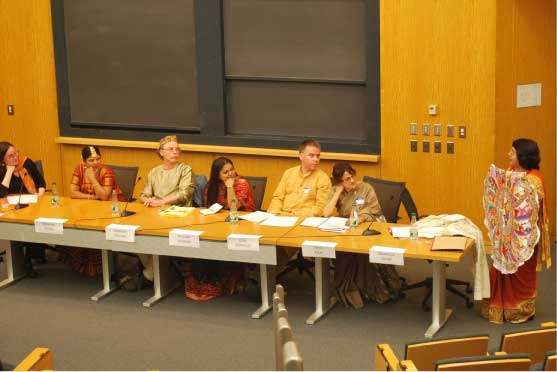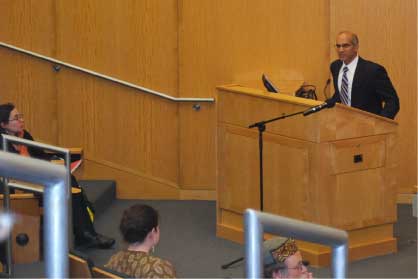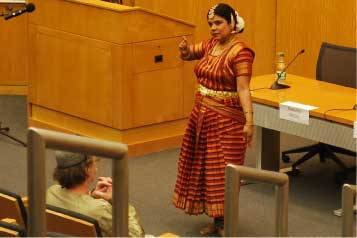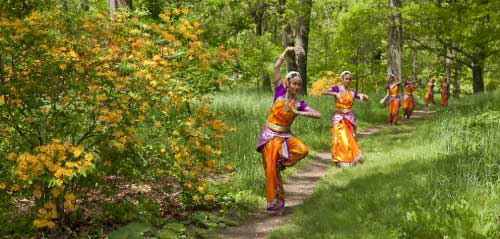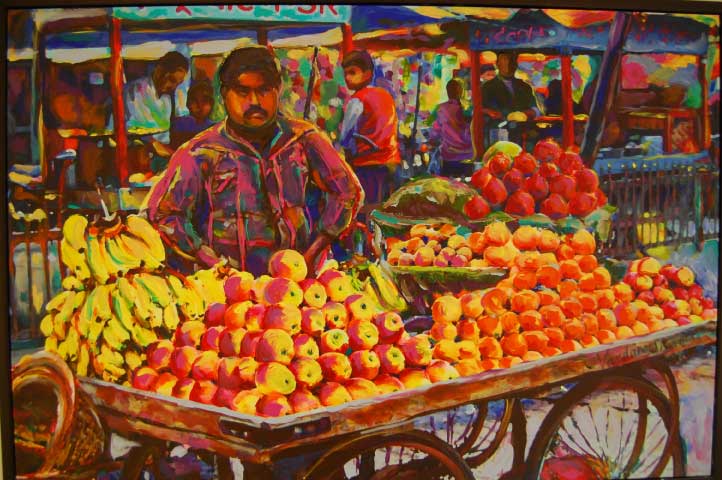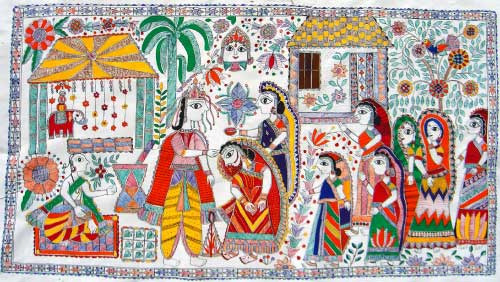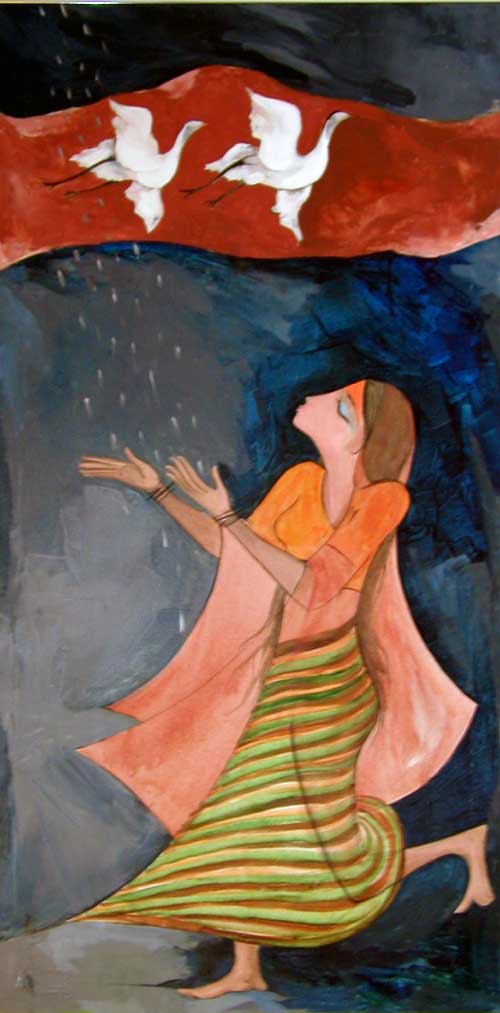Contribute
| South Asian Art Exhibit At Harvard – “Parallel Connections†|
Sunanda Sahay
03/29/2012
Last Friday evening, the Knafel Concourse was busy with connoisseurs of South Asian arts. The atrium was alive with colorful scenes from the streets of India and Afghanistan, stunning photos of ancient relics of Cambodia and Nepal, lyrical poses of dancers in elaborate costumes, and an assortment of Gods, Princes and Devis relating timeless tales and morals through images on canvas.
Sunanda Sahay, the brainchild behind the event and herself a folk artist from India, explained how the event came about. She found early support from Meena Hewett, Assistant Director of the South Asian Initiative at Harvard University, who liked the idea of exhibiting both traditional and contemporary art from South Asia and comparing it to performing and vocal artforms. Over the past few years, political events have thrust the South Asian countries to a close relationship with the US. What better way to foster understanding and appreciation than through culture and art?
Cultural expressions, however, are not limited to just paintings. Instead, the richness of cultural values and achievements find expressions in singing and dancing as well, particularly in South Asia where these classical traditions have unbroken lineages that go back hundreds of years. Thus was born the idea to explore the interconnections and common themes that underlie all visual and performing arts of South Asia.
LearnQuest Music Academy, a local organization that promotes Indian classical music and culture, also became an active sponsor of the exhibition which came to be called “Parallel Connectionsâ€. The exhibition runs for two months during March and April, and includes panel discussions on two evocative topics. The first, which concluded last Friday, brought together musicians, dancers and visual artists to discuss the common themes and thread that shape their narratives and styles. Bharatanatyam dancer, Ranjani Saigal , Hindustani vocalist Warren Sanders and photographer Don Perrault along with visual artists Sunanda Sahay, Pragati Sharma and Jyothi Joshi had wonderful discussion on training, performance and practice of their art. Laura Weinstein served as the moderator.
The next panel will be held at the Belfer Case Study Room at CGIS, 1730 Cambridge Street next week on 4th of April from 6p.m.-8p.m. involving Harvard doctors and exhibiting artists. This panel will explore the Healing Touch of South Asian Art. The moderator of this panel will be MGH Oncologist Dr. Bruce Chabner and guest doctors from Harvard University will be Dr. Elizabeth Gaufberg and Dr.Joel Katz. The doctors will share a slideshow to explain how they use visual art for Healing.
The event reception last week had more than a hundred visitors who were treated to a broad range of artistic styles and timelines. Commenting on the varied richness of art, Afshan Bukhari, Asst. Prof at Suffolk University commented: “The folk art quality gave the work the texture and nuance that is often omitted from South Asian art.â€
Walking down the hall, viewers were greeted by a wide variety of artistic talent. Sunanda Sahay displayed her colorful Madhubani paintings relating ancient stories of India. Dr. George Taylor (MGH) captured beautiful photographs from his travels to South Asia. Don Perrault, an electrical engineer, displayed his work on Indian classical dances. Pragati Sharma and Rachna Tiwari, two out-of-state Graphic Designers, shared Miniature and Warli art works of India. In front of the hall, sketches by Kyle Lindholm provided glimpses of Afghanistan. And adorning one long wall were Vandana Sharma's painting series called Street Nostalgia, a vibrant and lifelike depiction of street scenes from the city of Agra, famously known for its Taj Mahal.
To discuss the “Parallel Connections†between South Asian performing and visual arts, the panel included some of the exhibiting artists as well as performing artists Warren Senders (vocalist) and Ranjani Saigal (dancer). The event was moderated by Dr. Laura Weinstein, the MFA Curator of South Asia. The event started with opening remarks by Dr. Parimal Patil and graceful Bharatnatyam dance performance of Ms. Ranjani Saigal, and ended with a soulful performance in Raag Bhairavi by Warren Senders.
The panelists discussed early influences, the interconnections with other art forms, and how they deal with cultural gaps that they find in a foreign land. The remarks were often personal and insightful. Since the classical traditions are inspired from many of the same stories, the music, dance, poetry and paintings share a great deal of content. Sometimes the connections are so robust, that the artists are encouraged to learn other art forms in order to become a better performer. Warren elaborated on the Guru-Shishya (Teacher-Disciple) tradition, and the complex layering of stories that never seem to have a precise beginning or end.
A question from the audience initiated a discussion of the spiritual dimensions of these classical arts. Some artists described their art as means spiritual fulfillment while others saw it merely as a profession. Whatever their assertions, it was clear that the more they excelled in their art, the more humbled they felt. In sharing their artistic journeys, the artists touched on the pain and exhilaration of learning and performing, of following traditions and developing creativity, and the losses and gains from their migrations. In the end, all agreed that coming to the US has given their art new relevance and meaning, and allowed them greater creativity in shaping the propagation of art to the new generation. While the artworks were a treat to eyes, listening to the artists was even more enchanting. Ms. Weistein said that she had participated in many panels related to art discussions but it was a rare treat and very inspiring to hear the artists speak and express their views. For event info contact Sunanda at sun.sahay@gmail.com.
You may also access this article through our web-site http://www.lokvani.com/
